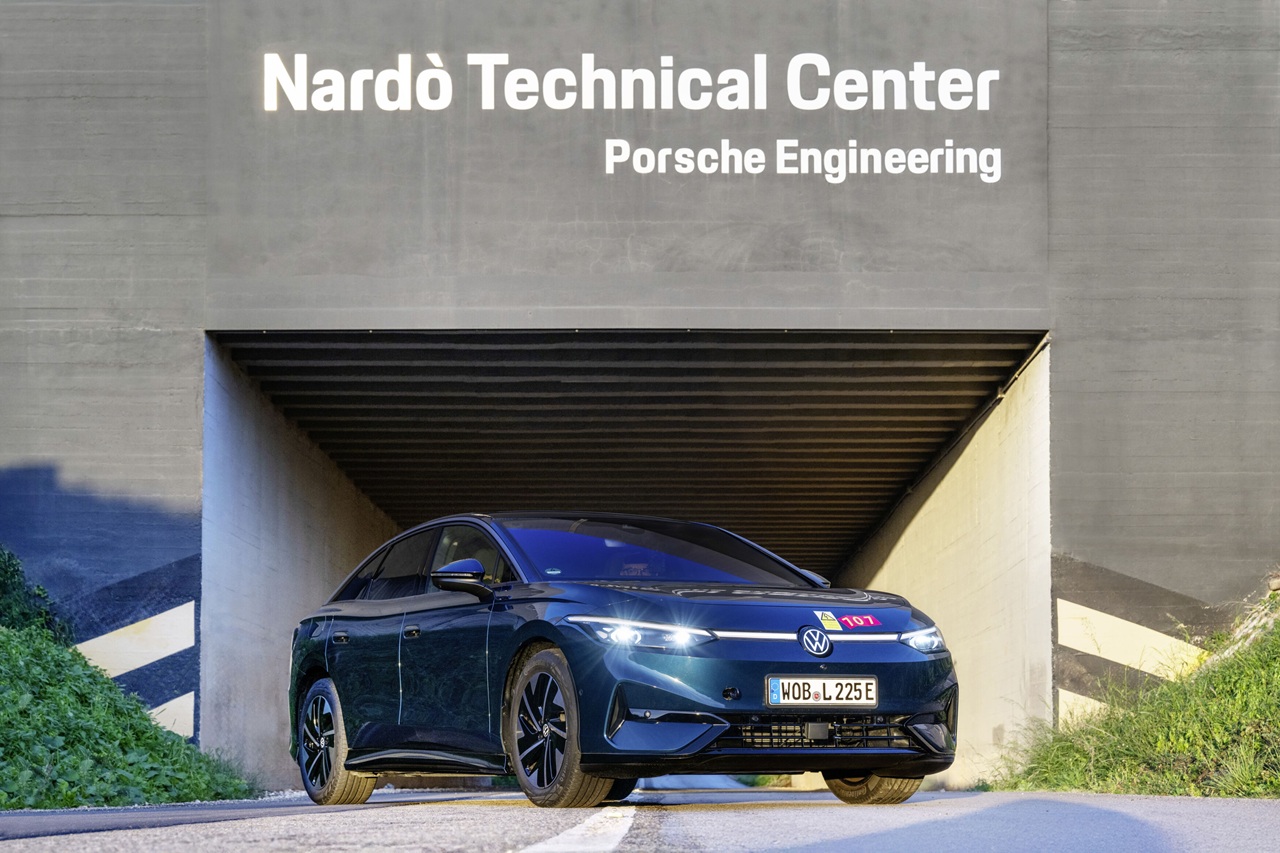- A standard ID.7 Pro S1 with no technical modifications consumed just 9.2 kWh/100 km in an efficiency drive
- WLTP range of up to 709 km2 exceeded by almost a third
- Long-distance electric driving: with its highly efficient drive, 86-kWh battery3 and top aerodynamics (drag coefficient of 0.23), the ID.7 Pro S can also achieve very long ranges in everyday use
- Martin Sander, Board Member for Sales, Marketing and Aftersales: “The ID.7 is currently one of our bestsellers. The feedback from customers is very positive.”
Wolfsburg – Volkswagen has reached a new efficiency milestone on a circuit in Nardò, southern Italy: an ID.7 Pro S with a standard technology package and 210 kW (286 PS) covered a distance of 941 kilometres on just one battery charge (86 kWh net). This significantly exceeded the model’s maximum WLTP range (combined) of up to 709 kilometres by 232 kilometres or 32.7 per cent. During the 941-kilometre tour, the ID.7 Pro S had an average consumption of just 9.2 kWh/100 km. Converted to a diesel equivalent, the average consumption achieved in Nardò corresponds to about just one litre per 100 km. The aim of the test in Nardò was to determine the maximum efficiency of the ID.7 Pro S introduced in 2024.
9.2 kWh/100 km. The test drive with the new ID.7 Pro S was completed in December by Volkswagen Driving Experience pro drivers on the Low Speed Ring in Nardò at ambient temperatures of five to 15 degrees Celsius. The 12.5- kilometre circuit enables a wide range of traffic scenarios and endurance tests to be simulated effectively. The average speed during the efficiency test was 29 km/h, which corresponds to typical rush hour speeds in large cities. According to the latest Traffic Index from navigation specialist TomTom, this figure ranges from 22 km/h (Hamburg) to 31 km/h (Amsterdam).
Extremely efficient overall vehicle. The ID.7 Pro S with an 86-kWh battery (net) is designed as a series production model for the greatest possible efficiency and has one of the highest ranges in its class of electric vehicle. The test car did not undergo any form of technical modification for the test, but instead came from current production at the Emden electromobility plant.
The foundations for the extraordinary efficiency of the ID.7 Pro S are the strong aerodynamics and state-of-the-art drive system. The drag coefficient is a low 0.23 (depending on equipment). The innovative, high-efficiency drive, known as the APP550, is as economical as it is powerful. The electric drive motor integrated into the rear axle develops a maximum torque of 545 Newton metres, enables the ID.7 to consume between 16.2 and 13.6 kWh/100 km in the official WLTP cycle and still accelerates the ID.7 Pro S from standstill to 100 km/h in a sporty 6.6 seconds if required. The ID.7 Pro S also charges particularly quickly while on the road thanks to a DC charging capacity of up to 200 kW. With this charging capacity, it takes on energy for a further 244 kilometres in just 10 minutes. At full DC charging capacity, the battery is charged from 10 to 80 per cent in about 26 minutes.
Positive trend in Europe. Be it the ID.7 Saloon or ID.7 Tourer – both variants are ideal for families and long-distance drivers. With plenty of space and a high level of comfort, they impress with their long all-electric ranges. Martin Sander, member of the Board of Management responsible for Sales, Marketing, Aftersales at the Volkswagen brand, said: “We are seeing a positive trend in incoming orders in Europe and are currently selling more ID.7 models than Passat. This shows that the ID.7 is a meaningful all-electric addition to the brand’s product portfolio and, in addition to our successful Passat, is also suitable for long distance drivers and as a company car.”
1) ID.7 Pro S – Combined power consumption 16.2–13.6 kWh/100 km; combined CO2 emissions 0 g/km; CO2 class: A
2) Range determined on the rolling road test bed in accordance with the Worldwide Harmonised Light Vehicles Test Procedure (WLTP) in the most range-favourable equipment variant. The actual WLTP range values may differ depending on the equipment. The actual range achieved under real conditions varies depending on the driving style, speed, use of comfort features or auxiliary equipment, outside temperature, number of passengers/load, topography and the ageing and wear process of the battery
3) The specified net battery energy content is a typical battery value that is independent of the vehicle. it is determined with a constant load profile under defined boundary conditions and takes into account the full usable battery energy content range until the vehicle comes to a standstill. The actual discharge energy may differ from this because it is dependent on the specific driving profile and battery temperature. The homologated range specification according to the WLTP legislation corresponds to the usable discharge energy for a new vehicle.
